Labrador Retriever
Dogs
Labrador Retriever
| Labrador Retriever |
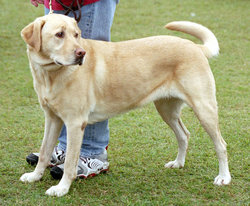
This yellow Lab's nose is pink rather than black.
|
| Alternative names |
| |
| Country of origin |
|
Newfoundland (now part of
Canada) |
| Common nicknames |
| Lab |
| Classification and breed standards |
|
FCI: |
Group 8 Section 1 #122 |
|
|
AKC: |
Sporting |
|
|
ANKC: |
Group 3 (Gundogs) |
|
|
CKC: |
Group 1 - Sporting Dogs |
|
|
KC (UK): |
Gundog |
|
|
NZKC: |
Group |
|
|
UKC: |
Gun Dog Breeds |
|
| Not recognized by any major kennel club |
| This breed of dog is
extinct |
| Notes |
| |
The Labrador Retriever ("Labrador" or "Lab" for short), is one of
several kinds of
retriever,
and are the most popular
breeds of
dog (by registered
ownership) in both the
United States and the
United Kingdom. The breed is exceptionally friendly, intelligent, and good
natured, and therefore makes an excellent companion, or
service
dog.
Appearance
Labradors are relatively large with males typically weighing 60 to 80 lb (27
to 36 kg) and females 50 to 70 lb (23 to 32 kg). They are energetic outgoing
dogs, and are black, yellow, or brown (called "chocolate") in color, in that
order of frequency. Puppies of all colors can potentially occur in the same
litter. The color is determined primarily by two genes. The first gene (the
B locus) determines the density of the coat's pigment granules: dense granules
result in a black coat, sparse ones give a chocolate coat. The second (E) locus
determines whether the pigment is produced at all. A dog with the recessive e
allele will produce little pigment and will be yellow regardless of its genotype
at the B locus[1].
Variations in numerous other genes control the subtler details of the coat's
coloration, which in yellow labs varies from white to light gold to a fox red.
Yellow labs can have black or pink noses; chocolate and black labs's noses match
the coat color. Lab hair is usually fairly short and straight, and the tail
quite broad and strong. The
otter-like tail
and webbed toes of the Labrador Retriever make them excellent swimmers. Their
interwoven coat is also relatively waterproof, providing more assistance for
swimming. The tail acts as a rudder for changing directions.
The Lab's head is broad and clean-cut, with ears that hang close
to the head.
|
In yellow Labradors, the nose can be black or pinkish.
|
In black and chocolate varieties, the nose color closely matches
the color of their coat.
|
The coat color of yellow Labradors, unlike the other colored
varieties, can be quite varied in the
phenotypical outcome; the displayed colors ranging from
white to fox red.
|
As with some other breeds, the English and the American lines differ
slightly. Labs are bred in England as a medium size dog, shorter and stockier
with fuller faces than their American counterparts which are bred as a larger
dog. No distinction is made by the
AKC, but the two classification come from different breeding. Australian
stock also exists; though not seen in the west, they are common in Asia.
Many people unfamiliar with retrievers find that the Lab is quite similar to
the
Golden Retriever in size, general shape, and general color, especially when
young and especially to those Goldens with lighter coats. The most obvious
difference is the short straight coat of the Labrador Retriever (the Golden has
long wavy fur) and the Lab's thick, otter-like tail compared to the Golden's
plumed tail. To confuse the two breeds would be a serious faux pas to a
fancier of either, of course.
History
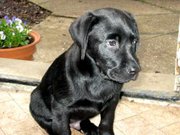 The coat of the black Labrador, like this puppy's, is solid black.
The coat of the black Labrador, like this puppy's, is solid black.
 This young Labrador's coat is chocolate, which was not always recognized
as an acceptable coat color. Now chocolate is accepted along with black and
yellow.
This young Labrador's coat is chocolate, which was not always recognized
as an acceptable coat color. Now chocolate is accepted along with black and
yellow.
The Labrador is believed to have originated on the island of
Newfoundland, now part of the province of
Newfoundland and Labrador, Canada. It is thought to have descended from the
St. John's Water Dog (no longer in existence), a
crossbreed
of native water dogs and the
Newfoundland to which the Labrador is closely related. The name Labrador
was given to this dog by the
Earl of Malmesbury and other breeders in
England in
order to differentiate them from the
Newfoundland dog. The Labrador Retriever was originally called the lesser
Newfoundland or the
St. John's dog. Other origins suggested for the name include the Spanish
or Portuguese word for workers, "labradores", and the village of Castro
Laboreiro in Portugal whose herding and guard dogs bear a "striking resemblence"
to Labradors
[2].
Many fishermen originally used the Lab to assist in bringing nets to shore;
the dog would grab the floating corks on the ends of the nets and pull them to
shore.
The first known written reference to the Labrador is in 1814 in "Instructions
to Young Sportsmen". In 1823 sporting artist
Edwin Landseer painted a black dog with white markings titled "Cora. A
Labrador Bitch," by which time it appears the breed was already firmly
established, with several of the nobility either owning or breeding them by the
end of that century. The first Yellow Lab on record, named Ben of Hyde, was born
in 1899.
The modern Labrador Retriever is among the oldest of the modern "recognized"
breeds; according to the
American Kennel Club, pedigrees exist back to 1878.
The Kennel Club recognized the Lab in 1903. The first registration of
Labradors by the AKC was in 1917; many English dogs were imported post
World War
I and these formed the foundation of the American variety.
Temperament and activities
Labradors are a well-balanced and remarkably versatile breed, adaptable to a
wide range of functions as well as making very good pets. As a rule they are not
excessively prone to territorialism, pining, insecurity, aggression,
destructiveness, hypersensitivity, or other difficult traits which manifest in a
variety of breeds, and as the name suggests, they are excellent
retrievers.
As an extension of this, they instinctively enjoy holding objects and even hands
or arms in their mouths, which they can do with great gentleness. They are,
however, prone to chew objects (though they can easily be trained out of this
behavior). The Labrador Retriever's coat repels water to some extent, thus
facilitating the extensive use of the dog in waterfowl hunting.
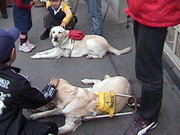 Labradors are often used as
guide dogs
Labradors are often used as
guide dogs
Labradors have a reputation as a very mellow breed and an excellent family
dog (including a good reputation with children of all ages), but some lines
(particularly those that have continued to be bred specifically for their skills
at working in the field rather than for their appearance) are particularly fast
and athletic. Their fun-loving boistrousness and lack of fear can result in
mischief, and may require training and firm handling at times to ensure it does
not get out of hand. Anecdotally, between the different subtypes, black Labs may
have a tendency to be slightly more dominant, and yellow to be slightly less so
(more mellow). Most Labs enjoy retrieving a ball endlessly and other forms of
activity (such as
dog
agility or
flyball), are considerably "food and fun" oriented, very trainable and open
minded to new things, and thrive on human attention and interaction, which they
find hard to get enough of.
The steady temperament of Labs and their ability to learn quickly make them
an ideal breed for
assistance dogs.
Health
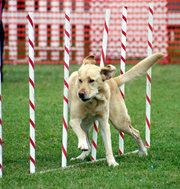 Some lines of Labs are fast and athletic, as demonstrated by this Lab doing the
weave poles in
dog
agility.
Some lines of Labs are fast and athletic, as demonstrated by this Lab doing the
weave poles in
dog
agility.
Labrador life expectancy is generally 12 to 13 years[3],
and it is a healthy breed with relatively few major problems. Common Lab health
issues are:
- Labs are somewhat prone to
hip dysplasia, especially the larger dogs, though not as much as some
other breeds. Hip scores are recommended before breeding.
- Labs are sometimes prone to ear infection, because their floppy ears
trap warm moist air. This is easy to control, but needs regular checking to
ensure that a problem is not building up unseen. A healthy Lab ear should
look clean and light pink (almost white) inside. Darker pink (or inflamed
red), or brownish deposits, are a symptom of ear infection. The usual
treatment is regular cleaning daily or twice daily (being careful not to
force dirt into the sensitive inner ear) and sometimes medication (ear
drops) for major cases. As a preventative measure, some owners clip the hair
carefully around the ear and under the flap, to encourage better air flow.
- Labs are often overfed and are allowed to become overweight, due to
their blatant enjoyment of treats, hearty appetites, and endearing behavior
towards people. A healthy Lab should keep a very slight hourglass waist and
be fit and lithe, rather than fat or heavy-set. Excessive weight is strongly
implicated as a risk factor in the later development of hip dysplasia and
diabetes,
and also can contribute to general reduced health when older.
Miscellaneous
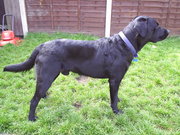 A black Labrador is structurally the same as a yellow Lab but the coat color
makes them look quite different.
A black Labrador is structurally the same as a yellow Lab but the coat color
makes them look quite different.
Puppy mills and dog theft
- Because the Labrador is such a popular breed, they are often reared in
puppy
mills where the people responsible care primarily for profit, and not
for the dog's well being.
- Labs and Lab owners also commonly fall victim to dog theft, where any
purebred-looking Labradors may be sold to puppy mills or unknowing
prospective owners for a high profit to the thief.
Microchipping for Labradors—as for any dog—increases the possiblity of
finding lost or stolen dogs, because the microchip cannot be removed in the
way that a collar and
dog tags
can.
Labrador variants
- Although kennel clubs and registries recognize the Labrador in
variations of only three colors—black, yellow, and chocolate—some breeders
sell light-colored yellow Labrador puppies as a "white" labrador, the dark
yellow Labrador puppies as "fox red," or chocolates possessing the dilution
factor as "silver Labradors". These colors are nonstandard and would
disqualify the dogs in the show ring; however, the dog's color does not
affect its behavior or health and many people own them as
companion dogs. There is some controversy over whether these rarer
colors are worth more (because they are rare) or less (because they are
nonstandard and unsuitable for breeding
show dogs
or for showing).
- The
Labradoodle is a common
mixed-breed dog that combines a Labrador with a
Poodle.
Famous Labs
-
U.S. President
Bill Clinton's pet Labrador was called
Buddy.
References
- Cunliffe, Juliette (2004). The Encyclopedia of Dog Breeds.
Parragon Publishing.
ISBN 0-75258-276-3.
3.
^ Fogle, Bruce, DVM (2000). The
new Encyclopedia of the Dog. Doring Kindersley (DK).
ISBN 0-7894-6130-7.
External links
1.
^
B/b, E/e, and Beyond: A Detailed Examination of Coat Color Genetics in the
Labrador Retriever, retrieved
November
12, 2005.
Home | Up | Labradoodle | Labrador Retriever | Lagotto Romagnolo | Lakeland Terrier | Lancashire Heeler | Landseer | Large Munsterlander | Leonberger | Lhasa Apso | Löwchen
Dogs, made by MultiMedia | Free content and software
This guide is licensed under the GNU
Free Documentation License. It uses material from the Wikipedia.
|




